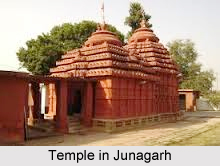 Tourism in Raurkela showcases pilgrimage tourism and the nature tourism destinations. As it is located very near to Kolkata and Jharkhand, Raurkela gives an opportunity to go to the destinations which are very near to Raurkela Iron and Steel Industry. Some of the major destinations in Raurkela are Vedavyas, Junagadh Pitamahal, Ushakothi, Ushakothi,
Mandira Dam, Khandadhar and Darjeeng.
Tourism in Raurkela showcases pilgrimage tourism and the nature tourism destinations. As it is located very near to Kolkata and Jharkhand, Raurkela gives an opportunity to go to the destinations which are very near to Raurkela Iron and Steel Industry. Some of the major destinations in Raurkela are Vedavyas, Junagadh Pitamahal, Ushakothi, Ushakothi,
Mandira Dam, Khandadhar and Darjeeng.
Vedavyas
Vedavyas is not only a place of natural beauty but also considered a "Tirtha", a place of religious sanctity. A Vedic Ashram and a school on the lines of Gurukul Ashram are the added attractions of the place. An ideal picnic spot, it is 5 km from Panposh.
Junagarh
A fort of historical and archaeological importance with some ancient caves having marks of tantra worship. It is 4 km. from Hemagiri and 15 km from Kanika.
Pitamahal
Pitamahal is famous for a small Dam project and ideal for outing in winters and late winters.
Ushakothi
Ushakothi is about 47 km from Sundargarh District and there lies the rock-cut caves, which contain some pictographic writings which are yet to be deciphered.
Mandira Dam
Mandira Dam is known to tourists as an ideal destination in winters, flows across the river Sankha. This dam was constructed for supply of water to Raurkela and other places in the vicinity. It presents a picturesque sight, ideal for holidaying and picnic. Boating facility is available in the lake on prior arrangements with the Dam Authorities. The permission to enter the Dam site is issued by the Officer-in-Charge at the main entrance.
Khandadhar
Khandadhar is about 244 metres in height. The waterfall at Khandadhar is said to be the loveliest waterfall in Odisha and it is a nice picnic spot.
Darjeeng
Darjeeng is located on N.H.No.23. It is a beautiful place on the Brahmani River, ideal for picnickers. 2 km away, approachable on foot is Deodarha, a gorge on the river.
Ghogar
A gorge on the river Ib, extending over 5 km, it is popular as a picnic spot. A naturally formed Siva Lingam of black granite worshipped by the local people is an additional attraction.
Eco Tourism in Rourkela
Raurkela has three recreation parks like Indira Gandhi Park, Jubilee Park and Ispat Nehru Park Udyaan which are attracted by the local and outlanders.
Bhanja Bhaban
Bhanja Bhaban and Civic Centre hosts the State level and National Level Drama, Fashion and Dancing competitions throughout the year.
Related Articles
Raurkela
Iron and Steel Industry in India
Odisha, Indian state
Temples of Odisha
Cities of Orissa
Konark Temple
Konark
Badaghagra Waterfalls



















